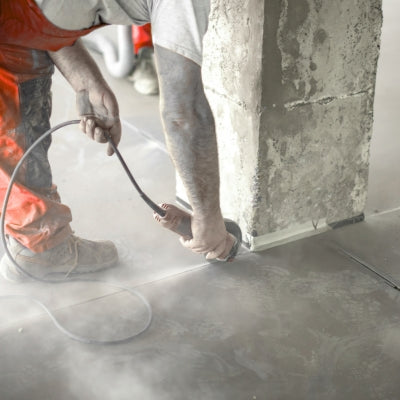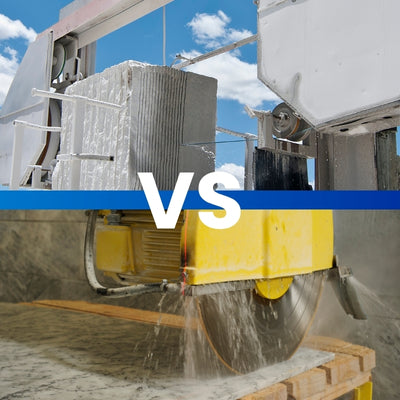
Share
Drilling concrete: how?
To drill through concrete and make a perfectly round hole in a hard material like rock, you can use one machine and one machine only: the core drill. This equivalent of a bricklayer’s hole saw is an extremely versatile tool that dates back to 1860. Inventor Rodolphe Leschote needed a better way to get blasting compound into rock, and the core drill was born.
A century and a half later has seen significant developments in this field, with several manufacturers introducing extremely resistant products to the market. Coring is a highly technical exercise that requires common sense, attention to detail and physical endurance.
Let's take a look.
Prepare the work area
As with any job, you need to start with the end first. You need to know what you are trying to achieve and why. Cores can be used in a variety of ways: straight cores for drainage or utilities, point cores for a new door or staircase, for sandblasting, for rod installation and many other reasons. When you know the what and the why, you can determine the how.
Core drilling requires your full attention. If your attention is on drilling, the work area must be prepared before you begin.
Drilling in concrete: key steps
- Identify all hazards, including potential ones that have not yet manifested.
- Delimit the work area so that you can concentrate exclusively on drilling.
- Check for utilities inside, around and behind the material to be drilled.
- Also try to locate any steel rebar. If possible, avoid it.
- Ask your supervisor, builder, or contractor to mark the location of the holes – they will know better than you.
- If you drill a slab, cordon off the area underneath so that mud and core cannot fall and injure someone.
- Make sure you collect the slurry properly.
- If drilling with a petrol-powered machine, make sure there is adequate ventilation.
- Make sure there is plenty of lighting.
- Wear all PPE, including hearing and eye protection. Keep spare PPE on hand.
- If working at heights, ensure that adequate height multipliers, such as scaffolding, are in place.
-
Consider how waste cores can be extracted.
-
Determine whether support is needed [the rule of thumb is that cores larger than 65mm produce enough torsional loading to require support].
-
Use the shortest extension cord possible due to voltage drop.
-
Remember that larger rods require more amperage due to rotational resistance. The same goes for deeper cores.
-
The maximum current draw can reach 25A, well beyond what traditional 240V sockets can provide [usually 10A].
-
Make sure the machine has been properly maintained and that all tools and other equipment are present.
-
Make sure you have the right cylinder for the job and that it is intact, that the cutting teeth are not blunt and that they are still attached.
Preparing the core drill for drilling.
This is one of the most critical components. An unsecured sled can cause problems.
- Make sure the threads of the barrel and the spindle of the machine are clean.
- Rotate the barrel onto the drill and tighten it by hand.
- Using the wrench provided by the manufacturer, tighten the barrel onto the machine so that it is secure. It will self-tighten as you drill, so there is no need to over-tighten the barrel at this stage.
- Test the machine to make sure the power is correct. This is a good time to make sure the power cord reaches the work area.
- Connect the water supply and turn it on to ensure adequate flow.
Drilling concrete freehand.
The general rule is that when drilling holes of 65 mm or less, the machine can be used without the support. This is called freehand coring. This method has external risks, such as imperfect alignment of the holes and potential injuries, but it has advantages, such as reducing working times.
- Try to assemble the diamond crown on the starting material to ensure that you can maintain control of the machine throughout the operation. This is especially important for vertical surfaces, odd angles or upside-down cores.
- Select the appropriate drilling speed. Coring machines have three gears: low, medium and high. Low gear reduces the speed of the rod but increases the torque. The opposite is true with high gear. Medium gear is a balance of both. The general rule is: the larger the rod, the lower the gear.
- Start the water flow.
- Place the teeth of the rod against the work and check the correct angle.
- Be prepared to counter the impending movement of the drill.
- Pull the trigger.
- Drill to the appropriate depth.
- Extract the barrel from the starting material with the barrel still rotating.
- Turn off the water supply, release the trigger and place the auger on a secure surface.
- Remove the carrot.
Remember that coring can be stopped at any time during the process. Often contact with rebar or other buried material will stop the drilling.
Diamond crowns for drilling reinforced concrete
To do the job perfectly, it is essential to choose the right diamond core bit for its use. If you have to drill holes in reinforced concrete you will need to buy some diamond drill bits specifically for reinforced concrete .
Our diamond core bits are produced in Italy at our factory. The segments have a height of 12mm with “roof top”. This technology allows you to drill reinforced concrete more easily, especially in the phase of entry into the material.



